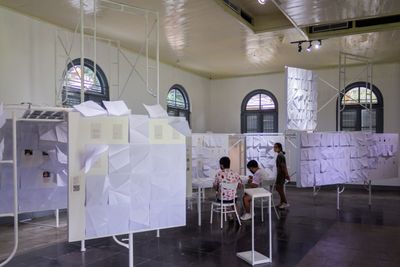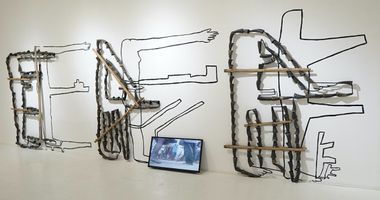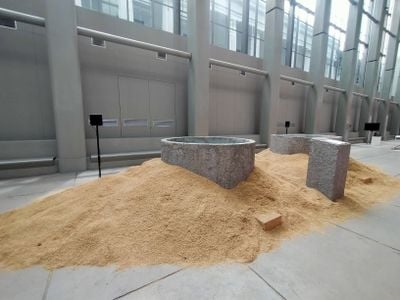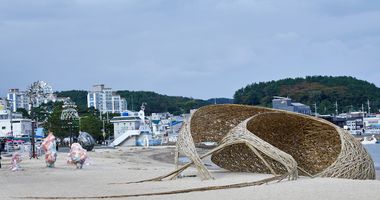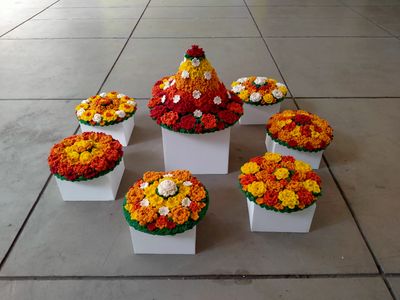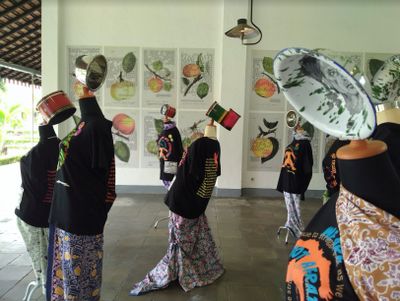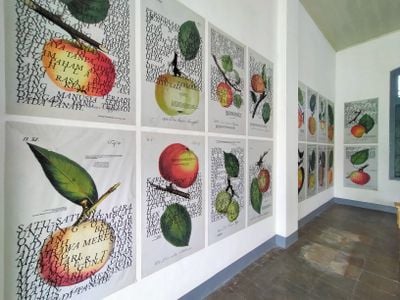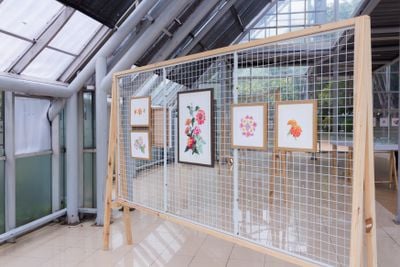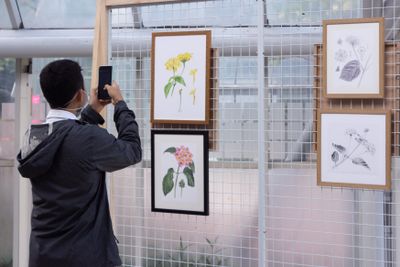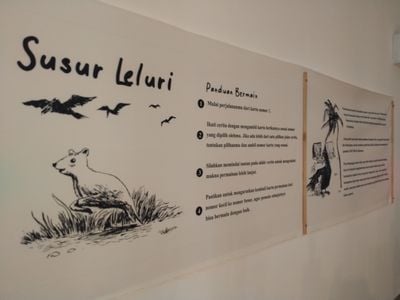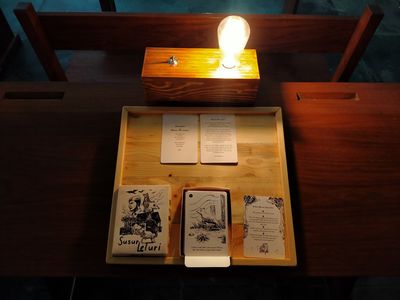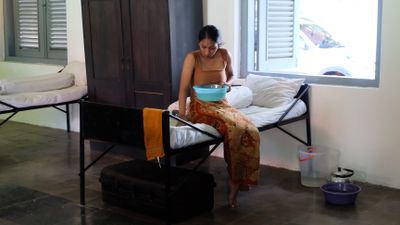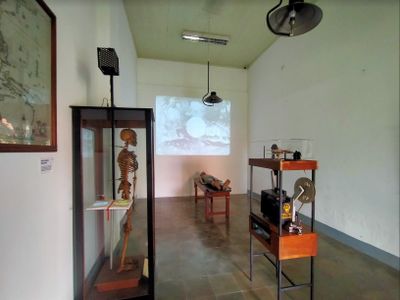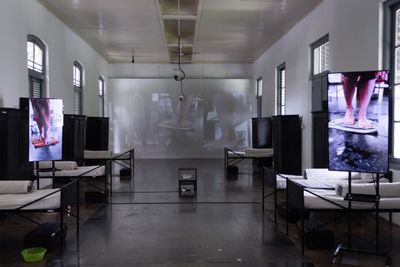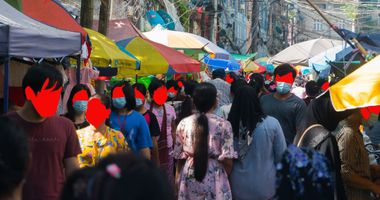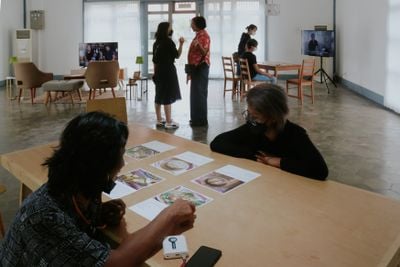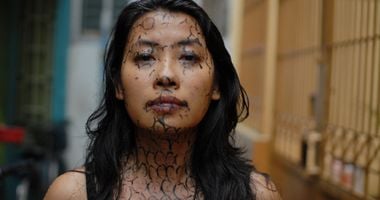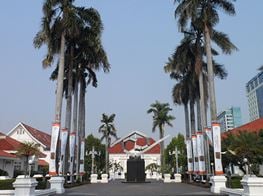Jakarta Biennale Takes Steps Towards the Immediate Future

Nadiah Bamadhaj, Merapal Mantra untuk Gerakan (Casting Spells for the Movement) (2021). Exhibition view: Jakarta Biennale 2021: ESOK, National Museum, Jakarta (21 November 2021–21 January 2022). Courtesy Jakarta Biennale.
Indonesia's oldest biennial has returned four years after its previous edition, with an exhibition that considers what lies ahead.
Titled ESOK—which artistic director Dolorosa Sinaga explains refers to the immediate future—the 2021 Jakarta Biennale (21 November 2021–21 January 2022) pays tribute to the Indonesian capital, which suffered greatly during the pandemic, while calling for societal and environmental change.
Curated by Grace Samboh, Sally Texania, and Qinyi Lim, the exhibition takes place in the National Museum, National Awakening Museum (STOVIA), and public spaces in Central Jakarta, with works by 38 Indonesian and international artists, among them Köken Ergun, Špela Petrič, and Krabstadt Education Center.
Taking centre stage at the National Museum is a monumental installation by artist duo Celia-Yunior (Celia Irina González Alvarez and Yunior Aguiar Perdomo) titled Wet Season – Dry Season (2021). Two round concrete tubs positioned within a mound of rice husks contain an amount of water based on what was preserved in two reservoirs built in Indonesia and Cuba during the Cold War.
The reservoir is a human attempt to control natural resources; ambitions that are inseparable from histories of modernisation and the events that define them. Small steps in front of each tub allow viewers to peer inside each tub, revealing years carved into the base: 1959 for the Cuban revolution and 1965 for the start of the genocide against communists in Indonesia, which eliminated the communist party as a political force.
Orienting views of resource management from past to future is Kenji Makizono's multimedia installation The Use of Energy (2018–2019), which revolves around a bicycle that audience members can ride to power amplifiers and electric guitars placed in front of four televisions.
Videos document the artist's band, assembled via public open call during an MMCA Goyang Residency at the National Museum of Modern and Contemporary Art Korea, and the performance of a song about shifts in energy policy in Korea and Japan.
This engagement with daily realities extends to sites in Central Jakarta, one of the three main Biennale locations, which act as conduits between museum and public space.
The project considers the consequences of artistic production—from the labour conditions of the amplifier manufacturer to the nuclear power that activates the band's instruments—and offers a proposal: to power the performance using bicycle power so the band can be paid instead of the energy companies.
This engagement with daily realities extends to sites in Central Jakarta, one of the three main Biennale locations, which act as conduits between museum and public space.
Consider the true-to-scale tumpeng with seven plates of offerings around it, positioned on the floor near the entrance to the National Museum, by Rajut Kejut, a yarn-bombing community involving hundreds of crochet artists throughout Indonesia.
Tumpeng is a common Indonesian platter consisting of assorted dishes surrounding a cone-shaped mound of rice that mimics the shape of a mountain, a symbol of life, prosperity, and natural harmony.
At first, the installation looks like any featured in slametan (blessing) ceremonies as a symbol of gratitude and prayer. But the offerings are composed of colourful knitted flowers rather than food.
Titled Sesaji Nusantara (2021), which roughly translates to 'Offerings of the Archipelago', the second part of this installation—a collaboration between 280 participants from 36 cities across Indonesia—is a monumental 2.7 by 2.1 metre tumpeng composed of hundreds of knitted flowers and fruits.
The tumpeng is located on top of a pos polisi, a small-sized police station commonly found in intersections of big streets in Indonesia, by the Cikini Raya main street across from the post office.
Another connection between public and exhibition space is the poster series by Inez Doujak titled 'Landraub' ('Land Grabbing', 2014–ongoing): illustrations of different apple varieties with original quotes from land grabbers covering their images.
Hitler is translated into Indonesian in one poster, highlighting the weaponisation of the natural resources through industrial capitalism. 'We will become a grain importing country for all of Europe that depends on grain imports', it reads. 'We will supply Ukraine with headpieces, glass bead necklaces, or whatever else captivates colonial society.'
Under the quote, a statement by the World Bank calls for new policy in Ukraine to attract investment in agriculture business.
Posters are presented on light poles along the walking path at Taman Menteng Park, leading to a glass house where a group exhibition extends the Biennale's discourse on imperialism and its implications on plant life.
Organised by artists Dương Mạnh Hùng, Hani Ristiawan, Trần Công Trọng, and IDSBA (Indonesian Society of Botanical Artists), the title Pengembara Molek | Cỏ Cắc Cớ | ꦏꦺꦝꦪꦺꦴꦲꦤ꧀ꦠꦩꦸꦮꦒꦸ (2021) is deliberately written in Indonesian, Vietnamese, and Javanese—with no English translation.
Featuring botanical illustrations, a sound installation, and journal pages written in Javanese, the exhibition revolves around the Lantana Camara, an invasive flowering plant that can rapidly colonise a variety of ecosystems. Through European colonisation, the species spread from its native Central and South America to around 50 countries, including those in Asia and Oceania.
With the impact of colonisation in mind, the National Awakening Museum (STOVIA) is a fitting Biennale venue. Constructed in 1899 and officially opened in 1902, this was originally home of the colonial medicine school for Javanese and other native people during Dutch colonisation.
The school produced a generation that gave birth to Budi Utomo, the first native political society that participated in disseminating ideas about nationhood and independence in Indonesia on 20 May 1908, officially remembered as the Day of National Awakening since 1948—three years after Indonesia declared independence.
Maharani Mancanegara's work Susur Leluri (2021) responds to the building's history. Using original tables from the old school to create a classroom setting, the installation reimagines the Indonesian fable of the mouse-deer, a cunning animal that enjoys stealing from a farmer.
While a video animation features snippets of the mouse-deer story accompanied by an instrumental version of a related children's song, a card game allows audiences to choose the mouse-deer's adventure while learning about the other animals' perspectives in the tale, each with their own opinion about the human-animal conflict. Defining history as an assemblage of individual choices, this interactive piece highlights the angles that exist to events often portrayed as a single story.
Another site-specific response to the museum is Erika Tan's collaboration with Dansity, a Jakarta-based dance collective consisting of Cynthia Arnella, Althea Sri Bestari, Nudiandra Sarasvati, Florentina Windy, and Yola Yulfianti.
AMOK:KOMA (2021) documents a performance choreographed by Yulfianti that took place on the Biennale's opening day in the dormitory room of the old school, filled with made beds, where a three-channel video installation now screens the dance.
The choreography draws from a Dutch colonial photograph of four women healers found at STOVIA, its Western gaze portraying the dukun bayi (healers and those who deliver babies traditionally) as 'witches'. Through dance, Tan's work explores conditions of contagion that pass through the collective body, here the rendering of traditional healing practices as Other, and how to heal them.
Reaching deeper into Indonesia's colonial history is Mencitra Bara Mewarta Wabah (Not a Light Touch) (2020–2021) by Rizki Lazuardi: a speculative response to a 1927 film by Willy Mullens, considered an early pioneer of Dutch cinema, which portrays how the colonial government responded to the Javanese plague.
The production of the Mullens movie, the establishment of STOVIA, and the plague all took place during the Dutch Ethical Policy (1901–1942), when every move by the colonial government was carefully measured in terms of a skewed ethics.
Lazuardi's installation highlights the absence in Mullens' film of one example of the colonial government's approach to plague control: the burning of an entire pest-invested village where everyone died of plague.
Making use of original contents in the room that were not allowed to be moved, the artist installed a book written by Indonesian doctors—among them STOVIA alumni Dr Tjipto Mangoenkoesoemo, a prominent Indonesian independence leader—in front of a human skeleton, opened on the page about that burned village.
Similarly, projected onto an original anatomical mannequin from the old medical school laying on a bed, are visuals combining a fragment of Mullens' movie with footage of burning houses.
Lazuardi's intervention resonates especially well in this time of the pandemic, which has brought so many histories and ongoing struggles to light.
One of those struggles is foreground in a small but meaningful political gesture embedded within Esok's virtual realm. 'မိုးသောက် (MOETHAUK)' ('Drinking in the Dawn') is a series of blog posts arranged by the Myanmar Art Resource Center and Archive and edited by Nathalie Johnston.
Presented on the Biennale's blog, the intention is to platform voices in the wake of Myanmar's military coup.
The conversation will no doubt expand when the Biennale's international symposium on art, activism, and human rights in a hyper-digitised world takes place in January 2022. A moment when the politics of small gestures will become a collective conversation. —[O]

